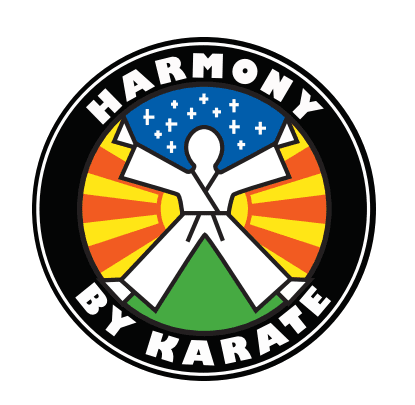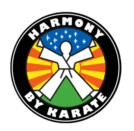HISTORY
Harmony By Karate's mission is developing empathic and inclusive global leaders. We are rated in the top 7 martial arts schools in the US for children and adults.
The Harmony Power Foundation, it's charity arm made US history establishing the 1st Mandated anti-bullying program in a major city-Elizabeth NJ!
In 1967, Sensei John P. Mirrione began studying Shorinjiryu karate at the age of two from his father. His early studies didn’t last long, but when he was 8 he was severely bullied on the streets of Brooklyn, NYC. Learning to defend himself was a matter of survival, so for about 6 months his father trained him in karate intensively and was able to stop the bully who endangered his life.
In 1979, it was only when he was 14 that he started to immerse himself in the serious study of Shorinjiryu karate and did so with his father for 26 years. Shorinjiryu is a strictly traditional style of karate developed by Kori Hisataka in 1946. This style emphasizes individuality more than most other styles of traditional karate.
After years of serious Shorinjryu study, building on this understanding, Sensei John believed that there was even more room for individual interpretation and he took the philosophy to a different level by encouraging more natural movement.
For example, students stand in natural postures as opposed to the traditional stances of the past, and their hands are kept softly in front of them as opposed to the more rigid hand postures. These changes enable students to move their bodies naturally, and because the posture is more relaxed, the hand and foot techniques can be executed more swiftly.
For example, students stand in natural postures as opposed to the traditional stances of the past, and their hands are kept softly in front of them as opposed to the more rigid hand postures. These changes enable students to move their bodies naturally, and because the posture is more relaxed, the hand and foot techniques can be executed more swiftly.
In 2006, Sensei John was introduced to Leo Fong by Adam James, his top student. This was one of Sensei John’s greatest influences was Leo Fong. Leo Fong has studied and mastered many styles of fighting and martial arts, and has developed his own style – Wei Kuen Do – which integrates many of them. Fong’s movement is very mindful and he integrates Kung Fu, Tai Chi and Boxing. Sensei John integrated the breath and flow of Wei Kuen Do into his method of Harmony By Karate.
Leo Fong was also a close friend and sparring partner to Bruce Lee. They influenced each other’s styles and approaches.
In one famous incident, Bruce Lee had a fight with the top Kung Fu master in Chinatown. Although Bruce Lee won, he was dissatisfied with his performance. He told Leo Fong, who then suggested that he incorporate angles of attack into his style, just like a boxer would use. Together they studied tapes of Mohammed Ali and within two weeks after the fight, Lee had installed a boxing apparatus in his home. One day Bruce Lee asked Leo Fong why he studied so many different martial art forms, and Leo responded: “I am looking for the ultimate” to which Bruce replied, “There is no ultimate, the ultimate is in you.” That idea profoundly influenced Leo Fong. And he, in turn, has influenced Sensei John. When Sensei John parted ways with traditional Shorinjiryu, he wondered whether to describe his style as Shorinjiryu, or Harmony By Karate. To answer, Fong said “You’re Harmony By Karate. You have to be what you are.” Harmony By Karate.”
In one famous incident, Bruce Lee had a fight with the top Kung Fu master in Chinatown. Although Bruce Lee won, he was dissatisfied with his performance. He told Leo Fong, who then suggested that he incorporate angles of attack into his style, just like a boxer would use. Together they studied tapes of Mohammed Ali and within two weeks after the fight, Lee had installed a boxing apparatus in his home. One day Bruce Lee asked Leo Fong why he studied so many different martial art forms, and Leo responded: “I am looking for the ultimate” to which Bruce replied, “There is no ultimate, the ultimate is in you.” That idea profoundly influenced Leo Fong. And he, in turn, has influenced Sensei John. When Sensei John parted ways with traditional Shorinjiryu, he wondered whether to describe his style as Shorinjiryu, or Harmony By Karate. To answer, Fong said “You’re Harmony By Karate. You have to be what you are.” Harmony By Karate.”
Coming full circle In simplifying his system, Sensei John was also influenced by Marcos Martinez, a martial artist who developed an appreciation for the real life applications of martial arts by fighting in the war in Venezuela for 12 years. Marcos learned that the mastery of a few powerful techniques is more efficient than the knowledge of many. If combatants get caught up in traditional postures or the application of too many movements, they can get hurt. He believes that learning a few gross motor skills makes for a better fighter. The peril of studying Martial Arts is that kata can became about memorization rather than functionality. Traditional kata develop muscle memory. Martinez’s influence helped Sensei John realize that the memorization of movements isn’t helpful, and can be dangerous because they don’t mimic real battle scenarios. In real battle, you’re dependent on using simple tools of striking and or grabbing – movements that go efficiently from point A to point B. The mastery of those simple movements is what determines your survival in the moment, should you find yourself in a real fight situation. Taking a few movements and learning to apply them to any situation is a hallmark of the Harmony By Karate approach.
In 2006, in his transformation to Chowakai Karatedo, known as “Harmony By Karate,” Sensei John adopted the philosophy to make things simpler, and more natural. In this shift, he moved closer to how the Okinawans trained. They would spend more time working on fewer moves. This teaching of learning a few movements and applying them to any situation was most famously applied by one of the greatest Samurai swordsmen of all time, best known as the author of the Book of Five Rings, Miyamoto Musashi. Musashi is known for achieving mastery over just 3 strokes of the sword. By adapting those to all situations, he was equipped to conquer all enemies.
Sensei John believes that it’s important to respect tradition, but places emphasis on evolving new traditions to move forward. Even as he’s made substantial changes, he has preserved the traditional aspects that he perceives to be simple, practical, and direct. The positive influences that form the essence of karate have been maintained, and elements like bowing, wearing white uniforms, using Japanese terminology, and doing meditation are an integral part of the Harmony By Karate training.
7 GENERATIONS
Harmony By Karate was founded in 1990 by Sensei John Mirrione Jr. The school’s lineage traces its origin to the beginning of karate in 1733.



